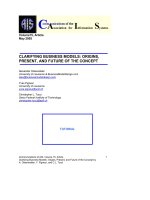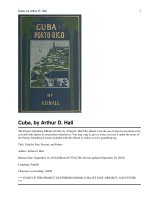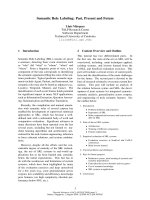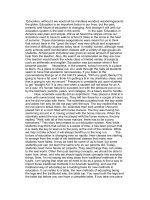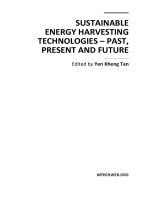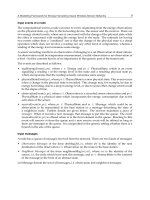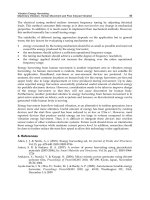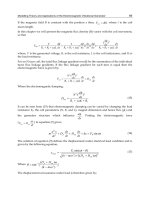Frozen shoulder present and future
Bạn đang xem bản rút gọn của tài liệu. Xem và tải ngay bản đầy đủ của tài liệu tại đây (20.57 MB, 361 trang )
APPENDIX
A patient’s perspective A
I am a 56-year-old woman, happily married with two adult children. I have been very
fortunate with my health—appendix removed age 9 years, two normal deliveries of
beautiful and healthy babies. I have a normal BMI although I have gained the
“Covid” stone and am working hard to lose it (I am finding this a challenge!). Prior to
COVID I was fairly active—I took up cycling and really enjoyed it but unfortunately
due to work commitments the regularity of any exercise declined to the point where I
would not describe myself as particularly fit. My good health meant interactions with
my GP were very irregular, the most recent was a general assessment which picked
up a high Cholesterol of 7.5 and treated with statins (10 mg); repeated screening after
6 months, but as the reading was 5 no change in treatment was required. I had also
presented about 4 years ago with significantly interrupted sleep pattern due to the
Menopause and treated with Hormone Replacement Therapy patches. I work full time
in a very busy job which is mainly sedentary and involves a lot of driving.
When did the pain and problems start and what was that
like, what were your thoughts and feelings?
Around October 2022 I started to wake with a sensation of a “dead” left arm, it was a
strange sensation because I would not describe it as particularly painful, but the “sensa-
tion” woke me. I had a full range of motion at this time and do not recall any limita-
tions. As it persisted for some time, I decided it best to consult my GP, who scheduled
an immediate appointment. After assessment by my GP a diagnosis of a “musculoskel-
etal” issue was attributed to the sensation and physiotherapy and paracetamol recom-
mended. Chatting to friends and work colleagues my general feeling was this was
because of poor posture, a lot of driving and working at a computer/laptop for signifi-
cant periods of time. “Rotator cuff” also came into conversations with friends and col-
leagues, I had some awareness as a friend had recent surgery on a rotator cuff injury.
How did the problem progress/evolve over time?
The “dead” arm sensation persisted, and my range of movement started to
become impaired. I got an appointment with a physiotherapist recommended by a
351
352 APPENDIX A A patient’s perspective
friend. On my first visit I recall that my movement was slightly impaired, and the
physio conducted several very “engaged/active” exercises. Over the next couple
of weeks my pain increased significantly, particularly after the physiotherapy ses-
sions. I progressed from paracetamol to over-the-counter anti inflammatories. My
sleep pattern was really affected, and I really was becoming more uncomfortable,
on reflection, I would describe the months of November, December, and January
as really miserable. I was really, really uncomfortable at night. I managed to cope
during the day only because I had an automatic car and the type of work I do is
mainly “administrative” so I was able to drive and attend the office.
What did you do about it/who did you see/what advice/
treatment did you get?
In the early stages I had no sense of what was to develop in the context of pain,
movement limitation and how long this would go on for. I had no sense of how
the severity or intensity of pain would evolve and what to expect.
My first port of call was to my GP, on their recommendation, I attended a
physiotherapist and started taking over the counter pain killers as my range of
movement decreased and my pain increased significantly, I reverted to my GP in
early December and was prescribed anti-inflammatories. I also started attending
an acupuncturist—anything to help with the increasing pain. As there was no
improvement, I actually felt worse, I contacted my GP again on the 19th of
December (I was really really uncomfortable and conscious of the looming
Christmas break which is why I remember this date) an MRI was requested, and
a different anti-inflammatory was prescribed. The MRI was scheduled for late
January. I hoped the new drugs would give me some relief as my discomfort was
significant at this point again most pronounced at night. A sling was mentioned to
wear intermittently for support, my posture had changed somewhat, so I was
holding/guarding my shoulder in an abnormal position, (really noticeable without
clothes). I purchased a sling that allowed arm movement and continued to attend
acupuncture. I also had purchased numerous “aids” pillows, Hot Packs Cold
packs, balms, etc. I had no real sense of what was wrong or what was causing my
pain, my memory suggests rotator cuff was mentioned in many conversations. My
GP advised that it was going to take a “long time” and my physio was somewhat
surprised at the change between sessions in the degree of increased immobility of
the joint. I found the sessions with the physiotherapist particularly difficult/painful
and in late December canceled the session until I had an MRI and could establish
what was going on. As the pain was so intense over Christmas, I rang my GP the
first working day after the holidays and advised that I was getting no relief and I
could not wait until the end of January—I was going to attend a private
Emergency Department and look for an MRI to establish what was going on. I
attended the ED, had an MRI and was advised that I had no rotator cuff tear but
APPENDIX A A patient’s perspective 353
there were a number of things going on which were probably the cause of my
pain. The MRI report was as follows:
“Moderate AC joint degenerative change with inferior impingement
Subacromial and subdeltoid bursitis.”
Supra spinatus tendinopathy with the distal tendinous attenuation.
No definite evidence for full-thickness tearing.
Underlying cystic changes within the superolateral lateral humeral head.
Infra spinatus intact. Some minor underlying humeral head edema.
Subscapularis and biceps are intact. Glenohumeral effusion plateau more marked
posteriorly
A referral to an orthopopedic surgeon was suggested. I asked for something
more immediate—pain relief—some time off work and said I would consult my
GP regarding the suggested referral. I attended my GP after a week (mid-January)
as the prescribed anti- inflammatories by the ED consultant did not work, my GP
provided words of reassurance and said that there were a number of “drug”
options but again reiterated that this could go on for a long time. The pain had
intensified and was no longer just associated with my shoulder but was now also
radiating down my left arm intensifying in my left cubital fossa so Amitriptyline
10mg prescribed with an option to increase if required. I took this for about 6À8
weeks with no noticeable relief, I increased to 20mg to see if it would improve.
On 24th February I attended a different physiotherapist, who had a different
approach to the one I first attended. Following a detailed history and clinical
examination Frozen Shoulder was diagnosed. The condition was explained in sig-
nificant detail but in a way that I could understand, treatments options outlined
and following discussion we agreed a pathway of treatment. I was extremely
relieved after this consultation because I knew what I was dealing with and how
it would be managed.
How was the condition/treatment explained to you?
I met a number of healthcare professionals over 5 months. All were very “nice,”
supportive and were keen to help me. They all had different ways of explaining
what might cause the pain. I do not recall Frozen Shoulder being mentioned
despite all these visits until the last interaction with the second physiotherapist. It
was then I got a definitive diagnosis that was explained to me and I understood
exactly what I had. I wish that I had met this Physiotherapist much earlier
particularly when my pain was at its worst. I was never offered an injection
into the joint, though I was hearing from friends and colleagues that this was an
option that often provided best relief. Anti-inflammatory drugs did not provide
any real relief, topical treatments were equally ineffective, but kind of made me
feel a bit better.
354 APPENDIX A A patient’s perspective
What was the outcome from treatment?
The drugs had no real effect, despite trying numerous prescriptions.
The physio I had in the initial stages was really painful, the slings and other
appliances like pillows, hot packs, cold packs, balms have little if any effect. I
was not offered an “injection” into the joint until I met the second physiotherapist
who said it could be considered.
The acupuncture was a session I enjoyed and always felt somewhat better after
it.
Do you have any advice for future patients and healthcare
professionals?
For patients
Any symptoms relating to your shoulder ask your health professional about a
definitive diagnosis and ask about frozen shoulder.
I found the whole experience a bit like having your first baby. . .. Lots of
information, anecdotal stories but no clear explanation or pathway and you mud-
dle through. . .. despite seeking and receiving professional advice.
You need to understand that it will take some time and a number of consulta-
tions to get a diagnosis and understanding of what’s going on. All of the different
consultations can result in significant financial costs
The “unknown” or no sense of what I was going through contributed to my
discomfort significantly—I had no real sense of what I had even with an MRI. I
was somewhat relieved that it actually demonstrated something (I wasn’t losing
my mind something was identified). This was also a worry and concern for my
family, as the pathway to recovery was very slow.
While this was a very debilitating condition, I think because I didn’t look sick
the severity was not really appreciated by all health professionals who saw me.
You may need to really emphasize your limitations.
Do a bit of research—try and get a health professional that has an interest/spe-
cialises in the area, it is worth seeking them out early on.
Consultations with healthcare professionals can take time (weeks) so look for
them early—ask to be put on a cancelation list. This really worked for me.
For healthcare professionals
Don’t forget the basics—history taking in its entirety, clinical exam will really
sign post this condition even without MRI.
Imagery should only be used in the context of the history and clinical exam.
APPENDIX A A patient’s perspective 355
Consider advising the patient to take time off work to concentrate on
exercises.
If the level of pain is not responding to oral medications (and increases to the
point of distraction) consider the alternative options like Ultrasound guided injec-
tion, don’t just stick with oral meds.
Remember the patient does not know what you know. Take a few minutes to
explain simply what you think is going on, give them a diagnosis and a plan of
treatment that they understand may change.
Advise them that there will be a high probability they will require a number
of consultations over a significant period of time. I had an expectation following
each consultation that the prescribed medications would work. I now understand
that this is not guaranteed.
CHAPTER
1 Living with a frozen
shoulder
Suellen Anne Lyne1,2 and Ernst Michael Shanahan1,3
1Rheumatology Department, Southern Adelaide Local Health Network, Adelaide, Australia
2Department of Medicine, University of Adelaide, Adelaide, Australia
3College of Medicine and Public Health, Flinders University, Adelaide, Australia
Frozen shoulder is a painful and debilitating condition. The experience that one
endures while living with a frozen shoulder can vary considerably from one indi-
vidual to the next and is dependent on a complex interplay of environmental,
somatic, psychological, and social domains. Although the pathognomonic depic-
tion of pain and loss of movement is well described in frozen shoulder literature
[1,2], what is often under-appreciated is the personal impact of protracted and
debilitating shoulder pain, and its potential for profound physical, psychological,
and socioeconomic consequences [3]. In this chapter, we explore the subjective
experience of living with a frozen shoulder, propose possible explanations for var-
iability in patient experience, and consider how an improved understanding of the
patients’ perspective may influence our approach to treatment.
Understanding the patient’s experience of living with a frozen shoulder is cru-
cial to the effective management of this difficult-to-treat disease as it may facili-
tate earlier diagnosis and focus treatment approaches based on patient priorities.
At the same time, empowering patients to effectively communicate with their cli-
nician provides invaluable feedback on treatment response and quality of life that
are relevant to ongoing management decisions. Understanding the patient’s per-
spective also introduces the opportunity for unexplored treatment options and
may improve adherence and overall satisfaction with care.
The pathophysiology and natural history of the disease will be detailed in later
chapters. In short, a frozen shoulder is characterized by severe shoulder pain and
limitation of both active and passive range of movement. Disease progression is
classically defined by three overlapping clinical phases. Phase one is heralded by
severe shoulder pain with progressive loss of motion. Phase two is manifested by
gradual reduction in pain, but persistent and considerable restriction in movement.
Phase three is marked by gradual resolution [4,5]. While the frozen shoulder is
considered a self-limiting disease, the extent of recovery varies and there are few
effective treatments available which alter the natural history of the disease [1,6].
Due to the protracted disease course, often lasting 1À3 years [7], there is a
Frozen Shoulder. DOI: © 2024 Elsevier Inc. All rights are reserved, including those for text and data mining, AI training, and similar technologies. 3
4 CHAPTER 1 Living with a frozen shoulder
consequential functional disability which impacts quality of life. Patients describe
difficulty with basic activities of daily living, such as showering, dressing, and
cooking [8]. The impacts of frozen shoulder can cause considerable disruption to
sleep, cognitive function, and emotional well-being and affect one’s ability to
engage with domestic, social, and occupational activities [9,10].
There is a growing body of evidence in qualitative literature that provides
detailed insight into the experience of an individual living with a frozen shoulder.
In the first part of this chapter, we will explore the lived experience of frozen
shoulder from the patients’ perspective, detailing:
1. the severity of the pain experience
2. impact on function and loss of independence
3. the psychological impact
4. challenges of the healthcare journey
Second, we consider factors that influence an individual’s experience of living
with a frozen shoulder, relating to pain perception and pain-related behaviors,
self-perceived health, and self-efficacy. Finally, we consider how an improved
understanding of the patients’ perspective may influence our approach to
treatment.
Subjective experience of living with a frozen shoulder
The severity of the pain experience
Pain is one of the hallmark features of frozen shoulder, with patients universally
reporting at least some pain during their disease course. Pain is most pronounced
during the initial, pain-predominant phase, of the disease. It may last months to
years and is of varying severity. Early in the disease course, the pain of frozen
shoulder is difficult to distinguish from other shoulder pathologies, such as rotator
cuff tendinopathy and joint arthrosis. It is typically described as a constant, deep,
aching pain that is diffuse and may involve the shoulder, scapula, upper arm, and
chest [11]. The pain is often worse at night and is exacerbated by movement,
such as lifting the arm in a certain direction. Unguarded movements, like reaching
for a falling object, cause an intense and sometimes crippling exacerbation of
pain [8].
Qualitative studies have suggested that the intractable nature and intensity of
pain dominates patients’ experience of living with a frozen shoulder [8,12À15].
Vivid descriptors, such as “excruciating,” “debilitating,” and “unbearable” pro-
vide some insight into the degree of pain experienced [14]. The unrelenting pain
affects all facets of a person’s life, impacting work, sleep, personal hygiene, inter-
personal relationships, and independence. Shoulder pain that interferes with sleep
may further intensify pain pathways and impact the level of coping [9,10]. The
prolonged duration and inescapable nature of the pain are particularly burdensome
Subjective experience of living with a frozen shoulder 5
and have consequential impacts on mental health [13]. Resolution of pain has a
major positive psychological impact, as improvement in pain enables those suffer-
ing with frozen shoulder to engage more effectively in physical therapies and
begin their recovery [14].
Impact on function and loss of independence
The pathognomonic feature of a frozen shoulder is loss of active and passive
range of movement of the shoulder, in all planes of motion. For a person living
with a frozen shoulder, the impact of this painful, restricted movement and conse-
quent loss of independence may be profound. The upper limb is fundamental to
many activities, often taken for granted. Activities such as dressing, driving, shop-
ping, and personal hygiene become difficult, or near impossible for some [8].
This is particularly evident for those whose dominant arm is affected and those
with limited social support [14]. Using a number of validated tools, such as the
Visual Analogue Scale, Disabilities of the Arm, Shoulder and Hand score, the 36-
item Short-Form (SF-36) health survey, World Health Organization Quality of
Life Scale short form (WHOQoL-BREF) and the Hamilton Depression Rating
Scale and Anxiety Score, studies have demonstrated that patients living with fro-
zen shoulder suffer significant functional disability and reduced quality of life
[16,17].
Qualitative studies suggest that patients living with frozen shoulder struggle to
accept and adapt to their newfound disability [13]. Disability prevents those
affected from participating in activities that bring joy, like playing sport or caring
for grandchildren [12]. Interrupted sleep causes fatigue and irritability, resulting
in an inability to function at full capacity at work. Inability to drive or catch pub-
lic transport promotes social isolation. In some cases, the physical restriction
caused by frozen shoulder makes it impossible to engage in social and occupa-
tional activities, resulting in loss of income or social isolation [8,12]. Patients per-
ceive that the severity of their illness and consequent disability is often under-
appreciated by others because of the “invisible” nature of frozen shoulder [8].
They report reluctance to rely on others for help, both at home and in the work-
place, while simultaneously becoming frustrated at others’ inability to appreciate
their incapacity [14].
The psychological impact
Living with a frozen shoulder may have profound psychological impacts, includ-
ing feelings of frustration, fear, low mood, and reduced self-worth [13]. Studies
suggest that patients with frozen shoulder may suffer anxiety, irritability, depres-
sion, and even the contemplation of suicide [14,17À19]. Although a correlation
has been identified between psychological disorders and frozen shoulder, and
those with psychological disorders appear to have more severe self-reported
6 CHAPTER 1 Living with a frozen shoulder
shoulder pain and functional restriction, a causative relationship has not been
determined [18].
There are many factors that influence a patient’s emotional well-being, includ-
ing premorbid mental health disorders, health-related anxiety, preexisting person-
ality traits, patient expectations, coping strategies, and social supports [16,18].
There are also many drivers of physiological distress in a person living with a fro-
zen shoulder. The unrelenting pain as well as interrupted sleep are key determi-
nants of mood [17]. Loss of independence or loss of income contributes to
frustration, reduced self-worth, and sometimes hopelessness. Qualitative studies
suggest patients with frozen shoulder often feel they are not believed about the
severity of their symptoms, with a lack of empathy and understanding emanating
from family, friends, colleagues, and members of the medical profession [14].
This lack of understanding and fear of being a burden further compound the psy-
chological impact [13].
Challenges of the healthcare journey
Another theme identified in qualitative literature exploring the lived experience of
a frozen shoulder highlights the challenges that patients face throughout their
healthcare journey. Delay to diagnosis is a common obstacle encountered by
patients with frozen shoulder. Medical and allied health professionals sometimes
lack awareness of this condition, leading to contradictory advice, inappropriate
investigation, and unacceptable delays to treatment [8,12,13]. An apparent lack of
compassion and empathy has also been reported, as members of the healthcare
team trivialize the severity of symptoms and fail to acknowledge their impact
[14]. If a patient’s experience is misrepresented or trivialized by the health practi-
tioner, this may propagate a negative self-image with resultant hopelessness and
disempowerment [20]. In contrast, frozen shoulder sufferers report a sense of
relief when their health practitioner can provide a diagnosis, prognosis, and man-
agement plan [13]. The knowledge of being understood eases apprehension and
provides patients with new hope [8,12]. The formation of a therapeutic relation-
ship and established treatment targets are undoubtedly important to the overall
healing process [12].
Factors influencing patient experience
Although patients living with a frozen shoulder share similar experiences of pain
and loss of movement, the perception of pain severity, functional impairment, and
level of coping can differ greatly from one individual to the next. The etiology
and pathophysiology of frozen shoulder remain poorly understood and for this
reason it is difficult to delineate the role of tissue damage and nociceptive stimu-
lation in perception of pain from frozen shoulder [21]. As is common in chronic
Importance of understanding the patient perspective 7
pain, the patient perceived experience of pain does not always correlate with the
state of the tissues and many factors across somatic, psychological, and social
domains influence pain modulation [21À25]. It has been consistently demon-
strated that expectations and preexisting personality traits influence one’s experi-
ence of pain. For example, catastrophizing and health-related anxiety are
associated with heightened pain experience and perpetuation of chronic pain at
six months [23,26]. In contrast, expectations of recovery and self-efficacy are
associated with lower levels of pain and disability [27].
Frozen shoulder studies have suggested that suffering is more closely linked to
psychiatric parameters rather than demographic factors or restriction in range of
motion. Those with psychological disorders have more severe self-reported shoul-
der pain and functional restriction [16,18,19,28]. The severity of pain experience
appears to be related to depression, whereas the perception of upper limb disabil-
ity correlates with anxiety [16,28]. Perceived stiffness is not related to structural
factors when assessed by dedicated MRI [21]. Another study has demonstrated
that the clinical symptoms of pain and restricted movement in a frozen shoulder
do not correlate with patients’ self-perceived health, based on the WHOQoL ques-
tionnaire, reaffirming that the experience of living with a frozen shoulder is dic-
tated by more than pain and functional limitation alone [15].
As illustrated by the qualitative literature above, patients with frozen shoulder
often feel frustrated and disempowered by the lack of understanding and empathy
offered by healthcare professionals. This sentiment has been echoed by other
qualitative work exploring chronic pain, even in specialist pain clinics, where it
seems that clinicians may lack the necessary knowledge to truly understand
patients’ experiences [3,8]. Such feelings are counterproductive to the therapeutic
relationship and increase the risk of anxiety and depression [25]. Given the bur-
den of psychological distress expressed by many patients with frozen shoulder,
and its correlation with increased suffering, it is imperative that these factors be
addressed when managing patients with frozen shoulder. Pain-related fear, pain
catastrophizing, and pain self-efficacy are important predictors of poor outcomes
in patients with frozen shoulder, so a strong therapeutic alliance based on a shared
understanding of the symptomatology, patient priorities, and treatment targets is
important [21,29À31].
Importance of understanding the patient perspective
The pathophysiology of frozen shoulder remains poorly understood. There are
limited effective treatment options available, and as such, well-defined manage-
ment guidelines are lacking. Traditionally, treatment approaches focused on phys-
ical therapy and joint manipulation to restore the range of movement, but without
a strong foundation of evidence [7,32À34]. Whether intervention can influence
8 CHAPTER 1 Living with a frozen shoulder
disease duration remains unclear and current therapies therefore focus predomi-
nantly on symptom reduction.
Patient-centered care defines a good outcome as one that is meaningful and valu-
able to the individual patient [35À37]. It involves listening to patients’ priorities and
empowering them to effectively critique and provide feedback on the quality and
appropriateness of healthcare services [38]. Increasingly, there is a push to incorpo-
rate patient-reported outcome measures (PROMs) and patient-reported experience
measures (PREMs) in routine clinical care of patients with musculoskeletal disorders
[36,39À41]. A PROM is any report of the status of a patient’s health condition that
comes directly from the patient [42]. PROMs, therefore, focus on the assessment of
symptoms, function, health-related quality of life, and satisfaction with the current
state of health. In contrast, PREMs capture the patients’ perspective of how care
occurred and evaluate the impact of care delivery [39]. Facilitating such channels of
communication promotes patient-centered care. Despite a greater focus on patient-
centered care, it seems there is often a discordance between the clinician’s objectives
in the treatment of frozen shoulder (i.e., increased range of movement and functional
capability) and patient priorities for managing their disease.
Qualitative studies suggest that patients’ priorities are pain minimization, pres-
ervation of independence, and management of psychological sequelae, as well as
a supportive therapeutic relationship with their practitioner [8,12À15]. Of these,
pain management appears to be the priority and a clear focus on early and effec-
tive pain management is therefore imperative. While targeting nociceptive signals
with analgesia and neural blockade can be helpful [43], providing education about
the mechanisms of chronic musculoskeletal pain is also of great importance [44].
Because frozen shoulder has such a protracted disease course, early education is
critical to ameliorate apprehension and formulate realistic treatment targets [45].
As with all chronic musculoskeletal pain, the development of a strong thera-
peutic relationship based on a shared understanding of symptomatology and treat-
ment targets is crucial to the management of a frozen shoulder [30,31]. Clinician
characteristics considered important to patients include communication skills,
confidence, knowledge and professionalism, an ability to relate, and transparency
of progress and outcome [36]. If a patient feels their struggle is understood, there
are profound positive impacts. It validates the individual’s experience, which
instills a sense of relief and hope, and reaffirms their functioning as a social indi-
vidual [3]. If the impact of a patient’s experience is underestimated by the health
practitioner, this may promote feelings of resentment or hopelessness [20]. Such
feelings are counterproductive to the therapeutic relationship and may intensify
the psychological impact of living with a frozen shoulder [25]. This is particularly
relevant given the burden of psychological distress reported by patients and its
association with increased pain and perception of disability. Both qualitative and
quantitative studies recognize the impact that a patient’s mental health and emo-
tional well-being has on their experience of a frozen shoulder, and this highlights
the need to be mindful of treating patients holistically, with the integration of
multidisciplinary care when indicated [16,18,19,28,37].
References 9
Conclusion
Understanding the experience of patients as they progress through their illness has
always been central to the delivery of good clinical care. However, there has been
a trend in modern medicine to focus heavily on the “scientific method” of health-
care delivery and emphasize investigation, diagnosis, and treatment over careful
listening and reflection on patients’ needs and perspectives. This approach has
resulted in major improvements in outcomes for a wide range of medical diseases.
However, with more complex conditions, it is being increasingly realized that
understanding and acknowledging the patient experience may be important to
improved management and better outcomes [46,47]. This is particularly true for
conditions that are chronic, disabling, and painful, and those that have significant
psychological sequelae. Frozen shoulder is an excellent example of such a condi-
tion, and by better understanding our patients who suffer from this affliction, it is
expected that we as clinicians will be in a stronger position to help them manage
and ultimately recover.
References
[1] Challoumas D, Biddle M, McLean M, Millar NL. Comparison of treatments for frozen
shoulder: a systematic review and meta-analysis. JAMA Network Open 2020;3(12).
Available from: />
[2] Hochberg M, Silman GE, et al. The shoulder. Elsevier; 2018.
[3] Harding G, Parsons S, Rahman A, Underwood M. “It struck me that they didn’t under-
stand pain”: the specialist pain clinic experience of patients with chronic musculoskel-
etal pain. Arthritis Care and Research 2005;53(5):691À6. Available from: https://doi.
org/10.1002/art.21451.
[4] Brun SP. Idiopathic frozen shoulder. Australian Journal of General Practice 2019;48
(11):757À61. Available from: />[5] Lewis J. Frozen shoulder contracture syndrome—aetiology, diagnosis and manage-
ment. Manual Therapy 2015;20(1):2À9. Available from: /> math.2014.07.006.
[6] Maund E, Craig D, Suekarran S, et al. Management of frozen shoulder: a systematic
review and cost-effectiveness analysis. Health Technology Assessment 2012;16(11).
Available from: />[7] Le HV, Lee SJ, Nazarian A, Rodriguez EK. Adhesive capsulitis of the shoulder:
review of pathophysiology and current clinical treatments. Shoulder and Elbow.
2017;9(2):75À84. Available from: />[8] Jones S, Hanchard N, Hamilton S, Rangan A. A qualitative study of patients’ percep-
tions and priorities when living with primary frozen shoulder. BMJ Open 2013;3(9).
Available from: />[9] Longo UG, Facchinetti G, Marchetti A, et al. Sleep disturbance and rotator cuff tears:
a systematic review. Medicina 2019;55(8):453. Available from: /> 10.3390/medicina55080453.
10 CHAPTER 1 Living with a frozen shoulder
[10] Page MJ, O’Connor DA, Malek M, et al. Patients’ experience of shoulder disorders:
a systematic review of qualitative studies for the OMERACT shoulder core domain
set. Rheumatology (United Kingdom) 2019;58(8):1410À21. Available from: https://
doi.org/10.1093/rheumatology/kez046.
[11] Millar NL, Meakins A, Struyf F, et al. Frozen shoulder. Nature Reviews Disease
Primers 2022;8(1). Available from: />
[12] Carter B. Clients’ experiences of frozen shoulder and its treatment with Bowen tech-
nique. Complementary Therapies in Nursing and Midwifery 2002;8(4):204À10.
Available from: />
[13] King WV, Hebron C. Frozen shoulder: living with uncertainty and being in no-man’s
land. Physiotherapy Theory and Practice 2022;1À15. Available from: /> 10.1080/09593985.2022.2032512.
[14] Lyne SA, Goldblatt FM, Shanahan EM. Living with a frozen shoulder À a phenome-
nological inquiry. BMC Musculoskeletal Disorders 2022;23(1). Available from:
/>
[15] She LC, Wang HY, Liu MF, Lin YK, Chen SM. The relationship between self-
perceived health and clinical symptoms in patients with frozen shoulders.
International Journal of Environmental Research and Public Health 2022;19(21).
Available from: />
[16] Bagheri F, Ebrahimzadeh MH, Moradi A, Bidgoli HF. Factors associated with pain,
disability and quality of life in patients suffering from frozen shoulder. Archives of
Bone and Joint Sugery 2016;4(3):243À7. Available from: /> cle_7148_84edfc1b746e352863069e4fc9a06cc7.pdf.
[17] Toprak M, Erden M. Sleep quality, pain, anxiety, depression and quality of life in
patients with frozen shoulder1. Journal of Back and Musculoskeletal Rehabilitation
2019;32(2):287À91. Available from: />
[18] Ding H, Tang Y, Xue Y, et al. A report on the prevalence of depression and anxiety
in patients with frozen shoulder and their relations to disease status. Psychology,
Health and Medicine 2014;19(6):730À7. Available from: /> 13548506.2013.873814.
[19] Ring D, Kadzielski J, Fabian L, Zurakowski D, Malhotra LR, Jupiter JB. Self-reported
upper extremity health status correlates with depression. Journal of Bone and Joint
Surgery 2006;88(9):1983À8. Available from: />
[20] Lewis H. Shame—the “sleeper”. Psychopathology: the role of shame in symptom
formation. Lawrence Erlbaum Associates; 1987.
[21] De Baets L, Matheve T, Dierickx C, Bijnens E, Jans D, Timmermans A. Are clinical
outcomes of frozen shoulder linked to pain, structural factors or pain-related cogni-
tions? An explorative cohort study. Musculoskeletal Science and Practice
2020;50:102270. Available from: />
[22] Eccleston C. A normal psychology of chronic pain. The Psychologist 2011;24
(6):422À5. Available from: /> home.cfm/volumeID_24-editionID_202-ArticleID_1861-getfile_getPDF/thepsycholo-
gist/0611ecclestone.pdf.
[23] Morley S. Psychology of pain. British Journal of Anaesthesia 2008;101(1):25À31.
Available from: />
[24] Moseley GL. Reconceptualising pain according to modern pain science. Physical
Therapy Reviews 2007;12(3):169À78. Available from: /> 108331907X223010.
References 11
[25] Smith JA, Osborn M. Pain as an assault on the self: An interpretative phenomenolog-
ical analysis of the psychological impact of chronic benign low back pain.
Psychology and Health 2007;22(5):517À34. Available from: /> 14768320600941756.
[26] Sullivan MJL, Thorn B, Haythornthwaite JA, et al. Theoretical perspectives on the
relation between catastrophizing and pain. Clinical Journal of Pain 2001;17
(1):52À64. Available from: />
[27] Martinez-Calderon J, Struyf F, Meeus M, Luque-Suarez A. The association between
pain beliefs and pain intensity and/or disability in people with shoulder pain: a sys-
tematic review. Musculoskeletal Science and Practice 2018;37:29À57. Available
from: />
[28] Ebrahimzadeh M, Moradi A, Bidgoli H, Zarei B. The relationship between depres-
sion or anxiety symptoms and objective and subjective symptoms of patients with
frozen shoulder. International Journal of Preventive Medicine 2019;10(1):38.
Available from: />
[29] De Baets L, Matheve T, Traxler J, Vlaeyen JWS, Timmermans A. Pain-related
beliefs are associated with arm function in persons with frozen shoulder. Shoulder
and Elbow 2020;12(6):432À40. Available from: /> 1758573220921561.
[30] Geenen R, Overman CL, Christensen R, et al. EULAR recommendations for the
health professional’s approach to pain management in inflammatory arthritis and
osteoarthritis. Annals of the Rheumatic Diseases 2018;77(6):797À807. Available
from: />
[31] Lin I, Wiles L, Waller R, et al. Patient-centred care: The cornerstone for high-value
musculoskeletal pain management. British Journal of Sports Medicine 2020;54
(21):1240À2. Available from: />
[32] Green S, Buchbinder R, Hetrick SE. Physiotherapy interventions for shoulder pain.
Cochrane Database of Systematic Reviews 2003;2003(2). Available from: https://doi.
org/10.1002/14651858.CD004258.
[33] Page M, Green S, Kramer S. Manual therapy and exercise for adhesive capsulitis
(frozen shoulder). Cochrane Database of Systematic Reviews 2014;(8)).
[34] Ryans I, Montgomery A, Galway R, Kernohan WG, McKane R. A randomized con-
trolled trial of intra-articular triamcinolone and/or physiotherapy in shoulder capsuli-
tis. Rheumatology 2005;44(4):529À35. Available from: /> rheumatology/keh535.
[35] Epstein RM, Street RL. The values and value of patient-centered care. Annals of
Family Medicine 2011;9(2):100À3. Available from: /> afm.1239.
[36] Kidd MO, Bond CH, Bell ML. Patients’ perspectives of patient-centredness as impor-
tant in musculoskeletal physiotherapy interactions: a qualitative study. Physiotherapy
2011;97(2):154À62. Available from: />
[37] Zeh S, Christalle E, Zill JM, Haărter M, Block A, Scholl I. What do patients expect?
Assessing patient-centredness from the patients’ perspective: an interview study.
BMJ Open 2021;11(7):e047810. Available from: /> 2020-047810.
[38] Pulvirenti M, Mcmillan J, Lawn S. Empowerment, patient centred care and self-
management. Health Expectations 2014;17(3):303À10. Available from: https://doi.
org/10.1111/j.1369-7625.2011.00757.x.
12 CHAPTER 1 Living with a frozen shoulder
[39] Bull C, Byrnes J, Hettiarachchi R, Downes M. A systematic review of the validity
and reliability of patient-reported experience measures. Health Services Research
2019;54(5):1023À35. Available from: />
[40] Fautrel B, Alten R, Kirkham B, et al. Call for action: how to improve use of patient-
reported outcomes to guide clinical decision making in rheumatoid arthritis.
Rheumatology International 2018;38(6):935À47. Available from: /> 10.1007/s00296-018-4005-5.
[41] Van Tuyl LHD, Boers M. Patient-reported outcomes in core domain sets for rheu-
matic diseases. Nature Reviews Rheumatology 2015;11(12):705À12. Available from:
/>
[42] FDA. Guidance for Industry: Patient-Reported Outcome Measures: Use in Medical
Product Development to Support Labelling Claims. Food and Drug Administration.;
2009.
[43] Shanahan EM, Gill TK, Briggs E, Hill CL, Bain G, Morris T. Suprascapular nerve
block for the treatment of adhesive capsulitis: a randomised double-blind placebo-
controlled trial. RMD Open 2022;8(2). Available from: /> rmdopen-2022-002648.
[44] Moseley GL, Butler DS. Fifteen years of explaining pain: the past, present, and
future. Journal of Pain 2015;16(9):807À13. Available from: /> jpain.2015.05.005.
[45] Manske RC, Prohaska D. Diagnosis and management of adhesive capsulitis. Current
Reviews in Musculoskeletal Medicine 2008;1(3-4):180À9. Available from: https://
doi.org/10.1007/s12178-008-9031-6.
[46] Black N. Patient reported outcome measures could help transform healthcare. The
BMJ 2013;346(jan28 1). Available from: f167-f167.
[47] Gibbons C, Porter I, Gonc¸alves-Bradley DC, et al. Routine provision of feedback
from patient-reported outcome measurements to healthcare providers and patients in
clinical practice. Cochrane Database of Systematic Reviews 2021;2021(10).
Available from: />
CHAPTER
2 The pathophysiology of
frozen shoulder
Neal L. Millar1 and Tim Kraal2,3
1School of Infection and Immunity, College of Medicine, Veterinary and Life Sciences,
University of Glasgow, United Kingdom
2Department of Orthopaedic Surgery, Flevoziekenhuis Almere, Almere, The Netherlands
3Department of Orthopaedic Surgery, Amsterdam University Medical Center, Amsterdam,
The Netherlands
The pathophysiology of frozen shoulders is a complex process, and most articles on
this subject state that the pathophysiology is poorly understood. But with the progress
that is made in recent research projects, we do get an increased amount of knowledge
on all the different factors that are related to this topic. This chapter aims to provide
a better understanding of the pathophysiology of frozen shoulders. This starts with
the anatomy of the glenohumeral joint capsule and its ligaments. An update on the
cellular processes and the complex pathway leading to tissue fibrosis is given.
Furthermore, the related immunological and endocrine factors are discussed.
Pathoanatomy
The normal shoulder has a glenohumeral joint capsule, which is a thin layer of con-
nective tissue surrounding the joint as a contained bag. An intact capsule preserves
the negative pressure in the joint, and the joint is filled with synovial fluid, pro-
duced by the synovium, the inner layer of the capsule. A normal glenohumeral joint
capsule is compliant enough to allow the remarkable wide range of motion of the
shoulder. The capsule is reinforced by several bandlike structures, the glenohumeral
ligaments and the coracohumeral ligament (CHL). The superior glenohumeral liga-
ment (SGHL) is a reinforcement of the anterosuperior capsule located on the articu-
lar side or inner side of the rotator interval. It originates from the supraglenoid
tubercle, just anterior to the long head of the biceps anchor, and inserts on the
humerus, above the lesser tuberosity, at the medial aspect of the bicipital groove,
just where the long head of the biceps enters the joint [1]. The CHL is located on
the extraarticular side, or the outer side of the rotator interval. It originates from the
dorsolateral base of the coracoid, spans the rotator interval, and is divided into two
bundles. The medial bundle attaches to the rolled upper border of subscapularis and
Frozen Shoulder. DOI: 13
© 2024 Elsevier Inc. All rights are reserved, including those for text and data mining, AI training, and similar technologies.
14 CHAPTER 2 The pathophysiology of frozen shoulder
the lesser tuberosity. The lateral bundle inserts onto the anterior border the leading
edge of supraspinatus and greater tuberosity. The medial bundle together with the
SGHL forms the medial biceps pulley complex and the lateral bundle is part of the
lateral biceps pulley complex [2]. The middle glenohumeral ligament originates
from the anterosuperior labrum, or the glenoid neck just medial to the labrum [1].
It runs obliquely across the intraarticular subscapularis tendon and attaches together
with the upper subscapularis tendon onto the lesser tuberosity. The inferior gleno-
humeral ligament is divided into an anterior band and an inferior band, with the
axillary pouch in between those two bands.
This glenohumeral joint capsule with its ligaments is the affected structure
responsible for the stiffness in frozen shoulders (Fig. 2.1AÀC) (rotator interval,
ligaments, and frozen).
The normal shoulder joint has a volume of at least 15 mL and on average
20 mL [3]. As the glenohumeral joint capsule becomes thicker and contracted and
loses its compliance, the joint volume can be less than 5 mL in frozen shoulders
[4]. Capsular stiffness is demonstrated in studies measuring intraarticular pressure
while progressively distending the capsule. Maximal intraarticular joint pressure
rises over 400 mmHg in frozen shoulder patients compared to 75 mmHg in
healthy controls, and capsular rupture occurs in frozen shoulders at a much lower
volume compared to normal shoulders [5À7].
The most characteristic finding of loss of passive external rotation and glenohum-
eral abduction is caused by a loss of compliance of the anterior and inferior joint cap-
sule and its ligaments. It is hypothesized that the pathophysiology of frozen shoulders
starts anteriorly, with a prominent role in the rotator interval. It has long been recog-
nized that the rotator with the CHL is involved in the pathophysiologic process of
frozen shoulders [8,9]. The CHL is strained in external rotation, and the release of
the CHL is an important part of the surgical release of a frozen shoulder [10,11].
There are more findings in the literature that support the important role of the rotator
interval in the etiology of frozen shoulders. A randomized trial showed that
ultrasound-guided corticosteroid injections in the rotator interval and around the CHL
had a greater effect on pain and range of motion compared to intraarticular corticoste-
roid injections directed from posterior [12]. Fluorodeoxyglucose (FDG)-PET CT
scans in frozen shoulders demonstrate that FDG uptake is predominantly located in
the rotator interval, anterior joint capsule, and axillary recess [13]. Angiography stud-
ies identified neovascularization with branching of the thoracoacromial artery, in the
rotator interval of frozen shoulder patients [14].
Pathophysiological mechanisms in frozen shoulder
Inflammation
While the exact pathogenesis of frozen shoulder remains under debate, there is
now growing acceptance for the central role of immune cells. Although past
Pathophysiological mechanisms in frozen shoulder 15
FIGURE 2.1
(A) A normal shoulder with the overlying rotator cuff muscles. (B) A normal shoulder with
the glenohumeral joint capsule in green and the glenohumeral ligaments in yellow. (C) A
frozen shoulder with thickening of the glenohumeral joint capsule and a contracted axillary
pouch.
studies have acknowledged the presence of inflammatory cells and proteins, as
well as describing an initial inflammatory phase of frozen shoulder, many have
underestimated the pivotal function of inflammation in driving the chronic fibrotic
pathology observed in frozen shoulder rather than focusing only on the final man-
ifestation of frozen shoulder, fibrosis. Various immune cells have been identified
in capsular tissue from frozen shoulder patients, including B cells, macrophages,
mast cells, and T cells [15À17]. There is growing evidence indicating a reciprocal
16 CHAPTER 2 The pathophysiology of frozen shoulder
relationship between immune cells and stromal cells within soft tissue, in both
health and disease and as we enter the single-cell genomic age, there is emerging
data of discrete subtypes of immune cells present in frozen shoulder, including
several subpopulations of dendritic and T cells. Immune cells and their mediators
have been implicated in driving the progression of many fibrotic disorders, and
there are now the beginnings of a greater appreciation for their role in soft tissue
diseases. While it is simple to explain the presence of immune cells in a purely
pathological context, their homeostatic and resolutory role in soft tissues has now
become evident. A subtype of macrophage that has been identified in remission
RA patients is phenotypically similar to a population of macrophages present in
healthy shoulder capsule which are reduced in disease [18]. Loss of these homeo-
static or resolutory cells could be indicative of a function for these cells in main-
taining healthy tissue.
Inflammatory cytokines
As frozen shoulder has been historically described as a chronic fibrotic disease of
the shoulder capsule, the main emphasis of cytokine studies has been on the role
of TGF-ß. Many studies have implicated its unequivocal involvement in fibrotic
disease, and frozen shoulder is no exception to this. TGF-ß is highly expressed in
frozen shoulder tissue [19], additionally, it can induce numerous cellular fibrotic
responses including matrix protein production, fibroblast proliferation, greater
myofibroblast differentiation, and collagen gel contractility [20]. Further to this,
other cytokines—COX-1, COX-2, IL-1, IL-6, IL-10, GM-CSF, M-CSF, platelet
derived growth factor (PGDF), and TNF-α—have been shown dysregulated in
diseased capsule [16,21] and may drive inflammatory and matrix responses.
Furthermore, fibroblasts cultured from diseased capsule produced elevated levels
of inflammatory cytokines (IL-6, IL-8 and CCL-20) in comparison to control
fibroblasts [22].
A further recent finding suggests a prominent role for IL-17A in frozen shoul-
der. Frozen shoulder tissue contained T cells which could produce IL-17A, T cells
were predominantly absent from the control shoulder capsule. IL-17A induced
greater profibrotic and inflammatory responses on frozen shoulder fibroblasts
compared to non-diseased fibroblasts as result of greater signaling receptor (IL-
17RA) on diseased fibroblast. The potential pathological effects of IL-17A are
notable due to its similar effect observed in tendinopathy, which is currently
under clinical trial for this soft tissue disease [23].
The cytokine IL-33 has also been found to be elevated in frozen shoulder tis-
sue, which can also act as an alarmin [24]. Alarmins are member of damage-
associated molecular patterns, which have been described and even associated
with clinical symptoms. Cher et al. examined H&E-stained capsular tissue from
frozen shoulder patients and found fibroblastic hypercellularity and increased vas-
cularity as well as high levels of the alarmins IL-33, high-mobility group protein
B1 (HMGB1), S100A8 and S100A9 the levels of which significantly correlated
Pathophysiological mechanisms in frozen shoulder 17
with the severity of patient-reported pain [24]. These alarmins can be released
from immune and stromal cells and may act as a conduit between the two
compartments.
Neural and vascular mechanisms
Although pain is probably the most fundamental symptom of a frozen shoulder,
the factors which cause this are poorly understood. Markers for nerves (nerve
growth factor receptor p75, growth-associated protein 43 [GAP43], protein gene
product 9.5 [PGP9.5]) are increased in frozen shoulder [16,24,25]. Additionally,
alarmins and cytokines which are linked to the pain pathway (IL-33 and IL-8)
have a role in frozen shoulder pathology, indicating inflammatory mediators could
play a role in the process of central sensitization.
Neovascularization is a common finding in frozen shoulder biopsies, empha-
sizing its critical role in its pathogenesis. Blood vessel and angiogenic markers—
CD34, ICAM1, VCAM1, and VEGF—are commonly shown to be upregulated
histologic and imaging studies of frozen shoulder [16,24À26]. The increased vas-
culature may explain the greater delivery of inflammatory cells and their media-
tors to the capsular site and these studies suggest that neoangiogenesis and
neoinnervation are pivotal in frozen shoulder, and the latter could explain the
unbearable pain associated with frozen shoulder. Central sensitization in frozen
shoulder has not been studied and so remains speculative, but this could explain
why some patients are resistant to current interventions and may benefit from a
different approach.
Matrix-related mechanisms
Fibrosis is the fundamental process manifesting as frozen shoulder. Fibroblasts
are the resident cell within the joint capsule and are responsible for laying the
extracellular matrix (ECM) which forms the structure of the tissue. In normal
homeostatic conditions, the primary matrix protein laid is type I collagen; how-
ever, under pathological conditions, the more immature and disorganized type III
collagen is laid as the requirement for matrix protein turnover becomes greater
[19]. In addition, there is an increase in several other structural matrix proteins
including vimentin, fibronectin, and tenascin C [27]. Furthermore, a group of
enzymes which regulate the matrix remodeling is also dysregulated in frozen
shoulder. Both matrix metalloprotineases (MMPs) and tissue inbibitor of metallo-
protineases (TIMPs) are dysregulated in frozen shoulder. MMPs 1, 2, 3, 4, 7, 8, 9,
12, 13, and 14 and TIMPs 1 and 2 have been reported to be involved in frozen
shoulder [27]. These proteinases have a vital role in ECM turnover with the bal-
ance between MMPs and TIMPS crucial in matrix remodeling and resolution.
This was highlighted in an anticancer treatment trial using the TIMP analog given
where 50% of the recruited patients developed bilateral frozen shoulder [28].
